In our last post here, we found the reasons as to why short term fund performance is not a great way to evaluate a fund manager’s skill.
The cyclical nature of market returns argues for evaluating manager performance over a full market cycle. When evaluating investment managers it is important to understand that managers can perform differently during various parts of the market cycle. Since a full market cycle incorporates a diverse range of environments, it provides a better context for performance evaluation.
While track records over entire market cycles may not be available for some managers, choosing a time frame which covers a wide range of market conditions provides the best context for fund manager performance evaluation.
Your mind voice: “Err..All this is fine. You make it sound elegant and intelligent (yawn). But if I were to be honest with you. Can you you please cut all this mumbo jumbo, and tell me how does this help me in real life? “
Oops..Apologies! I guess I got a little carried away. Anyways let us learn on how to put all this into action.
Putting “context” into investment returns
If you are someone who is planning to invest in equity mutual funds today, what will be your first starting point.
If you are like the rest of us, then the answer is simple – Past Returns!!
So you go to Value Research and find out the top 5 funds of the last 5 years.
(Since you have read my earlier posts here and here you have decided to ignore the shorter time frames (1 and 3 year returns) and go slightly longer.)

Returns as on 30-Jun-2017
Wow!! More than 30% compound annualised returns in the last 5 years ..Let me invest immediately!
Or if you are someone being advised, there is a good chance that you have been recommended one or all of these funds.
Obviously the 5 year returns are mind blowing and hence when we are recommended one of these, our natural tendency is to go and invest.
So how do we evaluate recommendations such as these?
This is where we need a checklist to ensure we put these returns in the correct context.
Checklist Question 1: Does the return period, cover an entire cycle – i.e is it sufficiently capturing both bull phase and bear phase?
In this case the recommendation to us is that the last 5 year returns have been great in these funds. So let us check on how the broader equity market fared in the last 5 years.

As seen above, the sensex has moved up from 17,500 levels to ~31,000 levels. Broadly the trend has been a bullish one, with some intermittent correction and consolidation in 2015-16 period.
This implies the current period of evaluation does not sufficiently capture an entire market cycle.
Further if you notice all the 5 funds are small and mid cap funds.
As we understood in our earlier post, mid & small cap segment also go through cycles and hence let us check which part of the mid cap cycle is the last 5 year period covering i.e from Jun 2012.

As suspected, the last 5 year period predominantly covers only the up cycle in mid caps. Hence a significant part of the returns is also because mid and small caps were o
Thus the first step is to ask your advisor, to extend the time frame to cover an entire cycle. i.e from 05-Nov-2010 till date
(A full market cycle can be defined as a peak-to-peak period that contains a price decline of at least 25% over at least a six month period from the previous market peak, followed by a rebound that establishes a new, higher peak. I have ignored the peak to peak from Mar 2015 till date period as the cycle is yet to get over and hence have clubbed it along with the earlier cycle )
Now let us see how the returns pan out over an entire cycle:
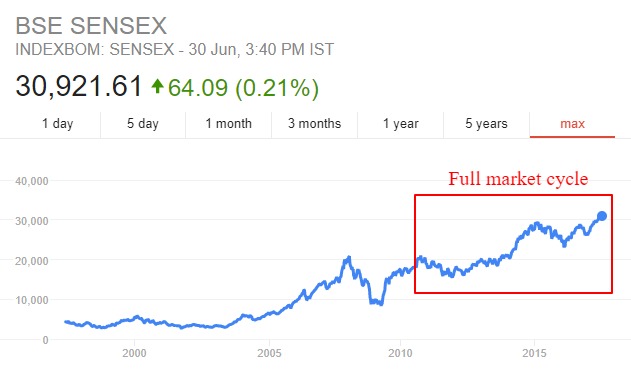
In 2011 there was a huge crash in mid cap funds. The same funds were down between 24 to 27% (except Mirae Asset Emerging Bluechip fund which was down by 15%) in the year 2011.
Yet, the full cycle returns for the 5 funds are extremely decent (due to fact that last 3 to 4 years mid cap segment had a significant rally) and are in the top 10 diversified equity fund returns across the entire cycle.
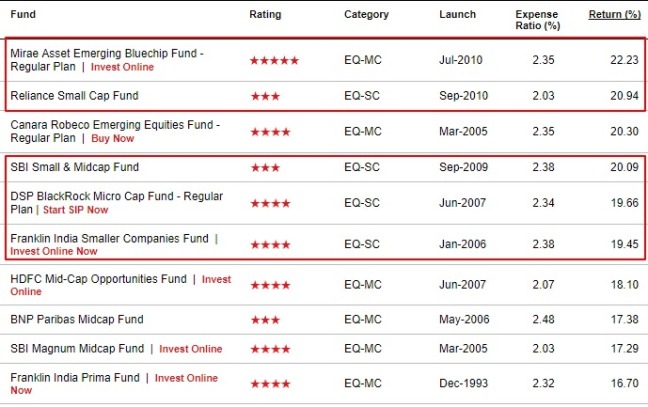
So all the funds look good as of now..Great!
Now the next step is to check returns across the earlier cycle which is between 10-Jan-2008 till 05-Nov-2010
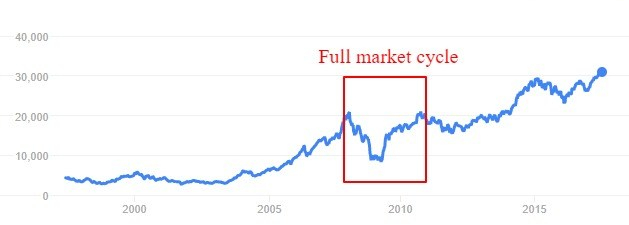
Three funds have not experienced the previous cycle
- Reliance Small Cap – Inception date – Sep 16, 2010
- Mirae Asset Emerging Bluechip Fund – Inception date – Sep 09, 2009
- SBI Small & Midcap Fund – Inception date – Jul 09, 2010
The fact that the above 3 funds have not experienced the 2008 recession period is a negative for us as we only have a limited track record over one cycle 😦
So let us check out the full cycle returns of the other two funds
Franklin India Smaller Companies Fund and DSPBR Microcap fund have track records covering the earlier cycle (from 10-Jan-2008 till 05-Nov-2010)
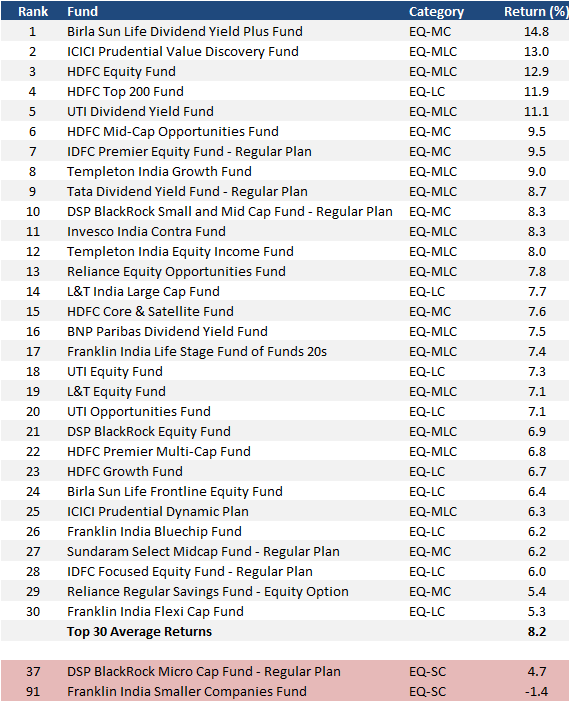
As seen above, Franklin India Smaller companies fund was a bottom quartile performer (97 out of 129 funds) with negative returns over the entire cycle.
DSPBR Microcap fund was a tad better but nowhere near its current performance. It was ranked 37 amongst 129 funds.
Even when compared with its peer group average Franklin India Smaller companies fund was in the bottom quartile.
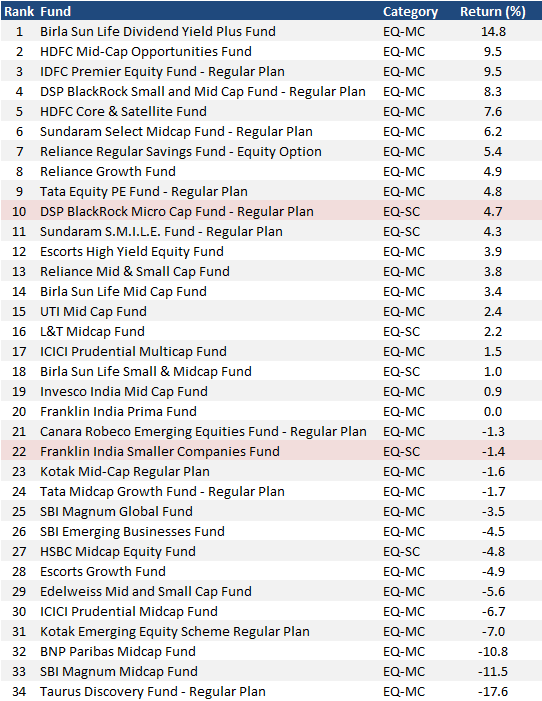
Thus the moment we extend our horizon to include 2 cycles it allows us to sober down, and provides a much more balanced view on these funds.
Now if you really think about it, the real time to have bought these funds is in 2013 period. But given the past returns at that juncture there is no way we would have invested in these funds.
Anyway the takeaway is that the top performers of today, weren’t the top performers of yesterday and hence we must keep our expectations in check (as we are only interested in reasonable performers of tomorrow).
Checklist Question 2: How long has the current fund manager been managing this fund? Has the fund manager changed in between?
Now to make sure the past performance evaluation is relevant, we need to check if the fund manager has remained the same
- Reliance Small Cap: Sunil Singhania since Aug 2010
- Mirae Asset Emerging Bluechip Fund: Neelesh Surana since May 2010
- There has been a CIO change in the fund house recently (link). My subjective opinion is that most often than not the CIO plays an important role in portfolio decisions in most of the AMCs especially in smaller ones. Hence this is a red flag for me and would want to evaluate the fund manager for some more time.
- SBI Small & Midcap Fund: R Srinivasan since Nov 13 – After SBI took over Daiwa AMC, Daiwa Industrial Leaders Fund, a large cap scheme was converted to SBI Small & Mid Cap Fund. So the track record before this is not too relevant. Red Flag!
- Franklin India Smaller Companies Fund: R Janakiraman since Feb 2008
- Longevity of fund manager is a positive and makes our evaluation across 2 cycles relevant
- DSPBR Microcap Fund: Vinit Sambre since Jun 2010
- This reduces the weightage we must place on our evaluation of the fund’s performance in previous cycle
Thus in effect except for Franklin India Smaller Companies Fund all the other 4 funds have relevant track records only for one cycle (SBI Small & Midcap Fund has it only from Nov-13)
Checklist Question 3: Is the fund manager managing other funds with similar strategy? If yes, how is the track record in other funds? And check if he has a longer track record in any other fund?
Reliance Small Cap is managed by Sunil Singhania who is also the CIO of Reliance mutual fund.
He manages Reliance Mid & Small Cap fund. But unfortunately the fund was earlier called Reliance Long Term equity fund (closed ended for sometime) and was changed to a mid cap fund only with effect from January 22, 2015 and hence the past performance may not be too relevant.
He manages another mid cap oriented fund (50% mid cap exposure) called Reliance Growth fund from 2004. However this fund has returned only 9.8% versus Reliance Small cap returns of around 20.9% in the 2010 till date cycle. This implies the higher returns in Reliance Small Cap may have been due to the focus on small caps.
SBI Small & Midcap Fund is managed by R Srinivasan who is also the CIO of SBI mutual Fund. He also manages SBI Emerging Business Fund. But however the fund after being the top performer in 2010,2011 and 2012 has significantly under performed in the last 3 years after its size increased. Its best return period came when the fund was sub 1000cr and was a relatively unknown fund
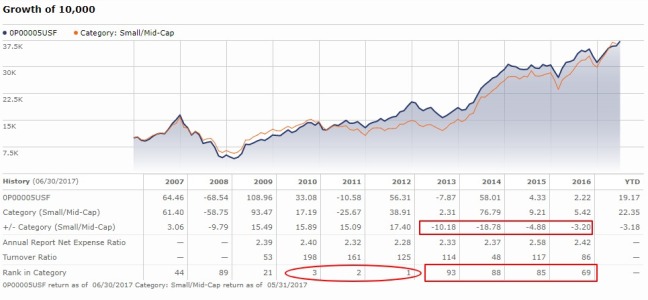
Similarly SBI Small & Mid was also sub 1000 cr and a relatively unknown fund before this scorching performance. Hence this raises concerns on whether the strategy is replicable at larger fund size. (but the good part this time is that the fund size has been capped)
Franklin India Smaller Companies Fund: R Janakiraman manages another mid cap fund Franklin India Prima Fund which gain has similar performance characteristics as Franklin India Smaller companies fund – under performed in the 2008-10 cycle and outperformed in the 2010-17 cycle.
DSPBR Microcap Fund: Vinit Sambre manages another mid cap strategy via DSPBR Mid & Small Cap Fund which has provided 14.5% over the 2010-17 cycle which is slightly below the peer group average. (again implying the relevance of small cap exposure in boosting returns for DSPBR Microcap fund)
Checklist 4: How consistent has the performance been? How has it performed during bad years?
For this we need to check the calendar year returns of every fund from morningstar.
SBI Small & Mid Cap Fund:
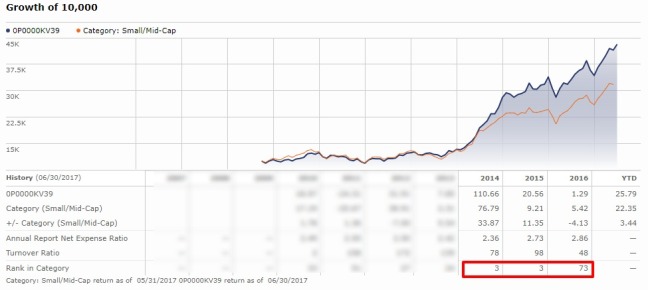
After 2 years of strong performance, the fund has under performed its peers in 2016.
Franklin India Smaller Companies Fund:
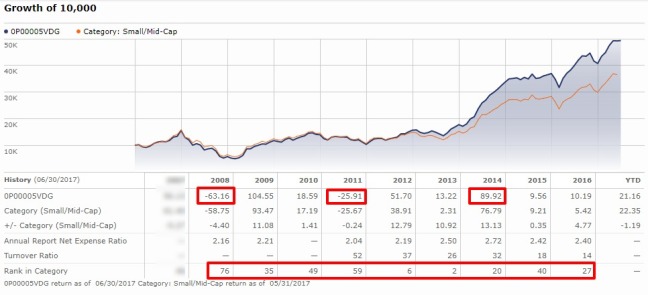
The fund has remained reasonable consistent across the last 5 years. However the declines during 2008 and 2011 were more than the category average
Reliance Small Cap

The fund has remained reasonably consistent across the last 6 years and has outperformed its peers.
DSPBR Microcap Fund
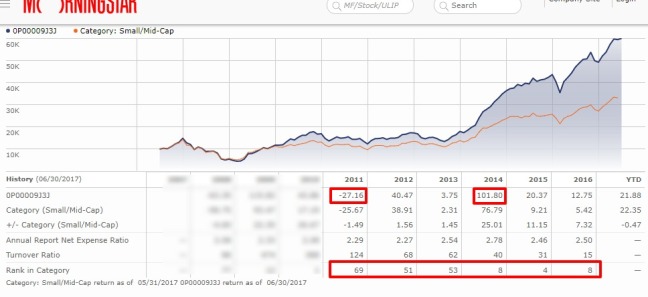
Good consistency in performance across the last few years
Mirae Asset Emerging Equities Fund

While the fund has been extremely consistent across the years with lower declines, but since there is a fund management change I am not considering this for analysis.
Checklist Question 5: Is the fund facing any size constraints (as strong past performance generally leads to investors chasing these funds and hence sudden increase in fund size)
Most of these funds seem to have either capped or stopped inflows citing possible size constraints if the fund were to grow further. While this is good for existing investors, for someone who wants to invest now, it provides a subtle message on the possible size constraints the category might be facing.
- Mirae Asset Emerging Bluechip Fund: INR 3898 cr (as on 31-May-2017)
-
Temporarily suspended fresh lumpsum subscription (including switches) in this fund w.e.f. 25th October, 2016
-
“Considering the significant flows which we are getting in the fund recently, we believe any large incremental inflow at this stage could be detrimental to the interest of the existing investors,” said Swarup Mohanty, chief executive officer, Mirae Asset Mutual Fund.
-
- SBI Small & Midcap Fund: INR 691 cr (as on 31-May-2017)
- No fresh subscriptions either as a lump-sum or through SIPs since 30-Oct-20115
- Franklin India Smaller Companies Fund: INR 5696 cr (as on 31-May-2017)
- No restrictions till date despite being a relatively large fund (5,696 cr) amongst the rest.
- DSPBR Microcap Fund: INR 5,818cr (as on 31-May-2017)
- In September 2014 it implemented a restriction of Rs 2 lakh for daily lump sum subscription. It was reduced further to Rs 1 lakh in August 2016.
- On 20 February, 2017, all subscriptions to the fund has been temporarily stopped
- Vinit Sambre, Senior Vice President and Fund Manager, DSP BlackRock said, “While we continue to find interesting investment opportunities for the fund to invest in, its current size poses the bigger challenge of liquidity. It is challenging to incrementally build positions, i.e. to increase stock weightage of companies to a meaningful size in the portfolio.”
- Reliance Small Cap: INR 3,767 cr (as on 31-May-2017)
- Removed restrictions from Jan-14. Earlier lumpsum investments were restricted to 5 lakhs
Trend of funds restricting flows implies possible liquidity constraints for the segment. Increasing valuations amongst stocks of this segment might also be another reason.
“When we speak about midcaps, some of the companies have become really expensive as compared to their historical norms. This is, in a way, linked to the kind of money flow coming into the market. As the markets are touching new highs, there is this typical bull market phase, where the retail investors also want to participate. Everyone is trying to seize the opportunity and put money in the market. So, I think there is some sort of frenzy in the midcap space. Valuations are high. I would be happier if there is some correction here” – Vinit Sambre, Fund Manager, DSPBR Microcap Fund
Source: ET
Checklist Question 6: What are the drivers for the recent performance? Is it only the fund or the category which has performed? If its the category, then what is the outlook of the category for the next 3-5 years?
The fact that all the top funds belong to the small & mid cap category gives us a mild suspicion that its the category that is the biggest driver of recent performance.

As suspected, that’s the case and hence we must first take a view on the mid and small cap category for the next 3-5 years before we decide on the funds. For this we need to evaluate the current valuations vis-a-vis possible earnings growth going forward and get an approximate sense of where we are in the mid cap cycle.
Summing it up:
Thus as seen above, from a simple “Wow, the 5 years performance is awesome – so let me invest!!” scenario, just by asking a few more questions we have managed to get a far better picture on the above funds.
Remember its your hard earned money. So whether you are investing on your own or with an advisor, do make sure to look beyond the short term performance and most importantly to understand the “context” of the current returns before you take the plunge.
This time, instead of me giving my final opinion on these funds, I have presented you with some interesting data on the above funds and will let you folks connect the dots and take a view on the funds. Also, do share your views via the comment section.
That’s a pretty long post. Phew.
As always happy investing folks 🙂
And just in case you like the contents,
Consider subscribing to the blog along with the 1400+ awesome people, so that you don’t miss out on the free weekly investment articles & other interesting updates delivered straight to your inbox.
P.S:
The framework or checklist as with all things in investing is an evolving process. And I tend to use a few more parameters while evaluating funds at my workplace as I have access to both the fund managers and other fund related data. Nevertheless, look at this as good starting point to evaluate returns 🙂
Disclaimer: All blog posts are my personal views and do not reflect the views of my organization. I do not provide any investment advisory service via this blog. No content on this blog should be construed to be investment advice. You should consult a qualified financial advisor prior to making any actual investment or trading decisions. All information is a point of view, and is for educational and informational use only. The author accepts no liability for any interpretation of articles or comments on this blog being used for actual investments
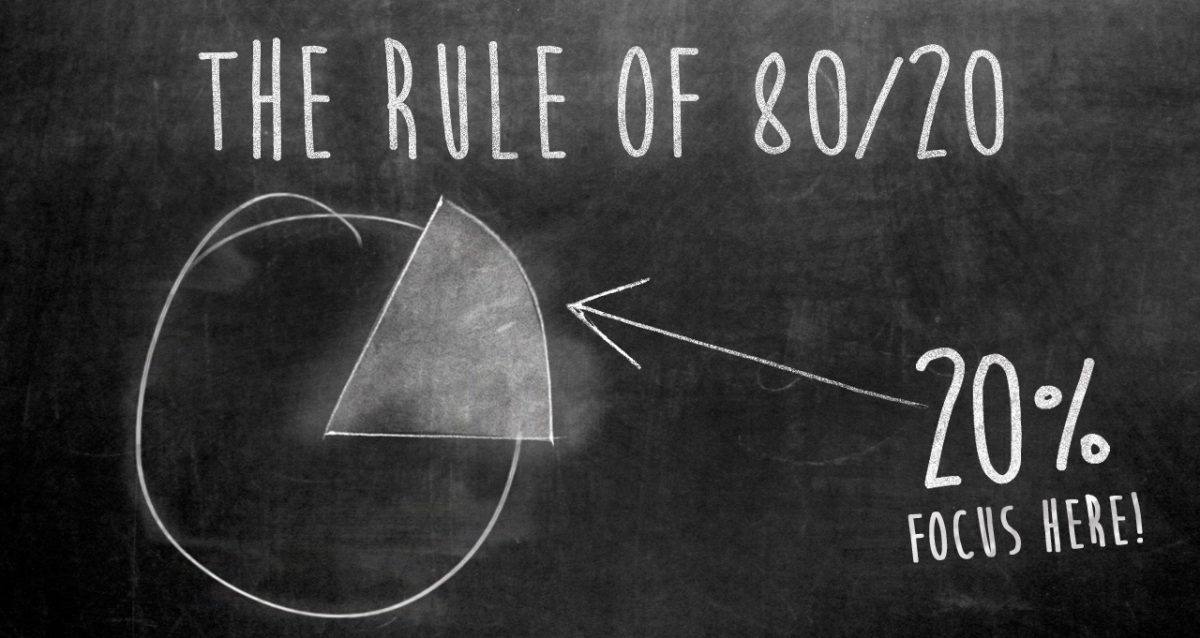

Really loved your simple and easy to understand language for the simple investors out there. Minus the technical jargon and presented with such simple graphs, your posts are a treat to read. Thanks a ton for all the hard work you put in your post!
LikeLike
Thank you so much Shiv 🙂 Glad you found this useful
LikeLike